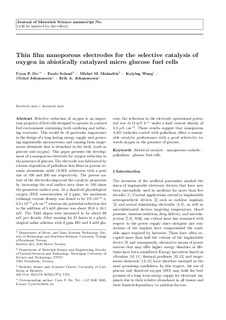| dc.contributor.author | Do, Uyen Phuong | |
| dc.contributor.author | Seland, Frode | |
| dc.contributor.author | Maharbiz, Michel M. | |
| dc.contributor.author | Wang, Kaiying | |
| dc.contributor.author | Johannesen, Øivind | |
| dc.contributor.author | Johannessen, Erik Andrew | |
| dc.date.accessioned | 2017-11-13T12:40:39Z | |
| dc.date.available | 2017-11-13T12:40:39Z | |
| dc.date.created | 2016-10-01T11:22:59Z | |
| dc.date.issued | 2016 | |
| dc.identifier.citation | Journal of Materials Science. 2016, 51 (19), 9095-9107. | nb_NO |
| dc.identifier.issn | 0022-2461 | |
| dc.identifier.uri | http://hdl.handle.net/11250/2465823 | |
| dc.description.abstract | Selective reduction of oxygen is an important property of fuel cells designed to operate in a mixed fuel environment containing both oxidizing and reducing reactants. This would be of particular importance in the design of a long-lasting energy supply unit powering implantable microsystems and running from exogeneous chemicals that is abundant in the body (such as glucose and oxygen). This paper presents the development of a nanoporous electrode for oxygen reduction in the presence of glucose. The electrode was fabricated by e-beam deposition of palladium thin films on porous ceramic aluminium oxide (AAO) substrates with a pore size of 100 and 200 nm, respectively. The porous nature of the electrodes improved the catalytic properties by increasing the real surface area close to 100 times the geometric surface area. At a dissolved physiological oxygen (DO) concentration of 2 ppm, the maximum exchange current density was found to be 2.9 × 10−3 ± 0.5 × 10−3 μA cm−2, whereas the potential reduction due to the addition of 5 mM glucose was about 20.6 ± 16.1 mV. The Tafel slopes were measured to be about 60 mV per decade. After running for 21 h in a physiological saline solution with 2 ppm DO and 3 mM glucose, the reduction in the electrode operational potential was −0.13 mV h−1 under a load current density of 4.4 μA cm−2. These results suggest that nanoporous AAO cathodes coated with palladium offer a reasonable catalytic performance with a good selectivity towards oxygen in the presence of glucose. | nb_NO |
| dc.language.iso | eng | nb_NO |
| dc.publisher | Springer Verlag | nb_NO |
| dc.title | Thin film nanoporous electrodes for the selective catalysis of oxygen in abiotically catalysed micro glucose fuel cells | nb_NO |
| dc.type | Journal article | nb_NO |
| dc.type | Peer reviewed | nb_NO |
| dc.description.version | acceptedVersion | nb_NO |
| dc.source.pagenumber | 9095-9107 | nb_NO |
| dc.source.volume | 51 | nb_NO |
| dc.source.journal | Journal of Materials Science | nb_NO |
| dc.source.issue | 19 | nb_NO |
| dc.identifier.doi | 10.1007/s10853-016-0162-7 | |
| dc.identifier.cristin | 1388656 | |
| dc.description.localcode | © Springer Verlag. This is the authors' accepted and refereed manuscript to the article. The final publication is available at https://link.springer.com/article/10.1007%2Fs10853-016-0162-7#enumeration | nb_NO |
| cristin.unitcode | 194,66,35,0 | |
| cristin.unitname | Institutt for materialteknologi | |
| cristin.ispublished | true | |
| cristin.fulltext | postprint | |
| cristin.qualitycode | 1 | |
